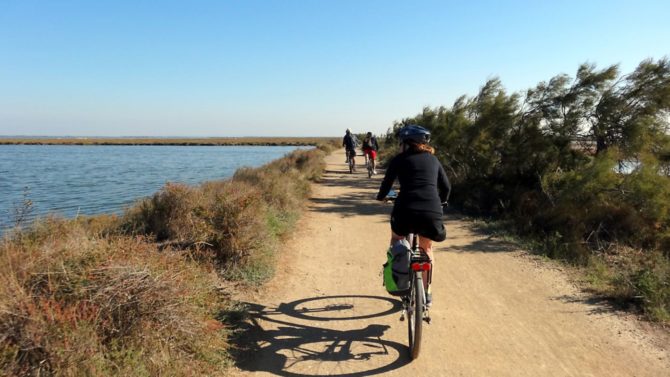Discover new hidden routes on your next cycling holiday

Finding your own new cycle routes can be a great part of a cycling adventure; Andy from Fellow Velo shares some tips on what to look out for when you are researching your rides off the beaten track

France has some wonderful long distance touring cycle routes. They are nearly all through great stretches of the varied French landscape, but even though they may be heavily promoted, the reality of the routes on the ground can be a mixed experience when riders eventually find themselves on the trail. A prime example of this is the Canal du Midi; rightly lauded for its UNESCO World Heritage status however, for some cyclists, it can be a more challenging ride than they were expecting. If you are drawn to the route because of all the glossy publicity that accompanies it and were expecting a pristine cycle path, you may be a little disappointed. However, if you love fairly easy-going, off-road cycling then routes like the Canal du Midi are great options for a touring adventure and, with some careful research and planning, great cycling experiences can be found throughout France.
Sometimes, planning your off-the-beaten-track cycling adventures can be almost as much fun as the time you spend on the trail. Even though you should always anticipate or expect things to be different on the ground when you get there, some active route planning will definitely help you prepare for at least the obvious elements along your route. While one or two guidebooks may help you make some big overall decisions, you probably don’t want to spend too much of your holiday fund on all the guidebooks that may reference the area you are going to explore, so remember that the internet can be fantastic aid. My first long-distance cycle tour was over thirty years ago and took me through France from top to bottom. One single Michelin map was our guide… how the internet could have changed our planning for the better!
Even if you don’t consider yourself to be a mountain biker, being open to the possibility of including some easy-going, off-road cycling within your tour can really open up a landscape for you. It can get you to some hidden locations, it will definitely heighten the sense of adventure and sometimes it can solve the problem of potentially missing links or a way to avoid more heavily trafficked routes.

Some key things to consider when remotely planning your own cycle routes, especially if you are going to venture a little off-road:
– Don’t just rely on one source of online mapping – sometimes different systems will have different names for the same routes, online mapping can suggest routes that don’t really exist and may not recognise some wonderful hidden routes that do.
– Use something like Google Street View wisely – not all possible routes will be covered by this facility but you can often look at the junctions where off-road options leave bigger routes and sometimes you will also be able to view points along otherwise ‘invisible’ routes via other junctions.
– Don’t just search on named routes through mapping facilities, you should also think about blogs that other cyclists may have published, but keep in mind their date and that changes may have occurred on the ground since they were written.
Once you are more certain of your probable route (or the corridor that you want to explore) then investing in the IGN 1:25,000 Blue Maps is really worthwhile. At this stage, you could also consider making contact with local cycling and mountain biking clubs (especially if you have some more specific route questions). We have a local VTT (vélo tout terrain) club near our base in Provence who have been a great help – cyclists tend to help other cyclists. Such approaches are really useful when you have uncovered conflicting or ambiguous information about particular route options e.g. when signs might not mean what they appear to mean for a cyclist.
It is also worth checking on some particular websites for both general and specific information. One of the best and most helpful general sites about cycling in France is www.freewheelingfrance.com where you can find ideas for tours and articles on all sorts of cycling aspects. Depending upon where and when in the calendar that you are planning your adventure there may also be other more specific websites that you should definitely be looking at (before you go and while you’re there). Much of our cycling is in Provence and, particularly in the summer months, that means keeping a watch on the department’s forest fire website. Make sure you know the current situation in areas where such risks exist and plan ahead for your own potential diversions where they might most likely occur.
Good planning really can be great fun. You will probably end your cycling adventure thinking that there was more you’d have liked to have known in advance, but that is all part of the experience. At least your planning will have built your anticipation, hopefully uncovered most of the highlights to come and prepared you for a great and safe cycling adventure.
We are always happy to hear from people who may be thinking about their first cycling adventure and if you are just looking to gain the confidence to venture a little off-road along the way, we’d be very happy to offer whatever guidance and support we can (even if it’s just with a simple call or email).
You can contact Fellow Velo by emailing [email protected] or, through our website www.fellowvelo.com
Share to: Facebook Twitter LinkedIn Email


